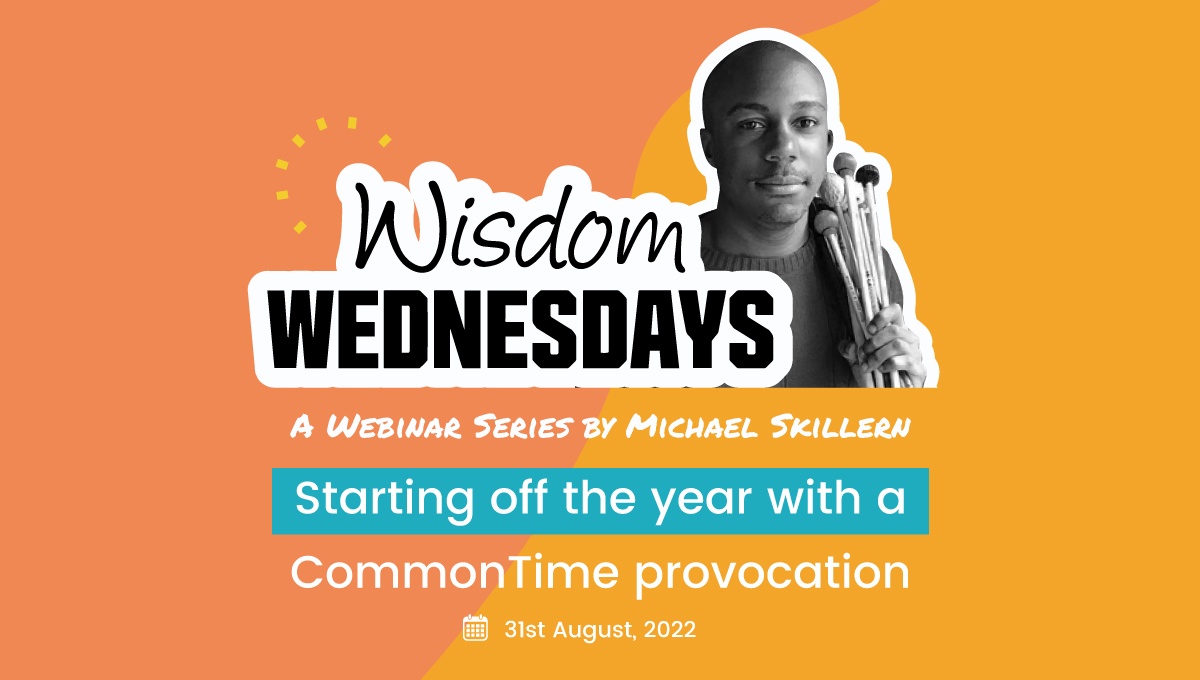Greetings, arts educators!
Welcome back to Wisdom Wednesday! This week, Michael from the CommonTime Education + Outreach team discussed how you can use CommonTime to help you provoke thought in your students during the first unit of the new school year.
Watch the full webinar below:
The definition of provocation is just as open-ended as the outcomes of such an activity. A provocation is an activity that provokes thought in your students. There are many reasons to use provocations in your classroom. Here are a few good ones:
- Provocations promote inquiry
- Provocations are teacher guided, but student led
- Provocations promote differentiation
- Provocations help to assess prior knowledge
- Provocations help reveal student interest
- Provocations help expose what your students don’t know, allowing you to gear units towards what they don’t know vs. what they do know
- Provocations help introduce new units to students and prepare them for what is to come
Provoking thought with the inclusion of a one-of-a-kind cultural arts experience will take your students’ learning experience to the next level. Here are some specific examples of how you can use CommonTime to help you provoke thought during the first unit of the new school year.
Visual Art:
Imagine a unit on watercolor painting. Then, imagine having a vetted, world class, CommonTime visual artist come into your classroom to showcase some of their artworks, explain watercolor techniques, introduce brushstrokes, and even paint something live. Your students could respond to this experience with the sticky note provocation. Essentially, each student is given a small stack of sticky notes. At any point, students can write down any thought, idea, memory, or question regarding the experience and post it to some central location in the classroom. From the memory you can assess prior learning. From the thoughts and ideas you can determine student interest within the topic. From the questions you can find what the students don’t know in addition to their interest. You can even provoke further thought by challenging the students to conceive an original idea only they could think of. They can provide a memory that only they can remember. They can ask a question that only they can ask. With all of this data you are prepared to fully differentiate the learning experiences to come next.
Music:
Imagine having a CommonTime musician come in to showcase a new genre, instrument, or style of play to be studied during a particular unit, and perform. You could then have your students take part in a jigsaw provocation. Bring out the sticky notes and split the class into groups. One group can produce ideas, thoughts, memories, and questions regarding just the instrument. Another group can do the same in regards to the music only. Then, the two groups can present their notes and their separate provocations can combine into one full picture. This method works well because it helps narrow the focus of the students’ thoughts. This narrowing allows for deeper thought. For more advanced students that may be learning to analyze music, consider splitting the students into groups focused on different elements of music. Maybe one group only observes rhythms. Maybe another observes the dynamics. Another could observe the form or the pitch. When the students come together, they will have a complete picture of thoughts that can lead to an analysis.
Drama:
Imagine bringing a CommonTime theater artist in to open up a unit on emotions with some improv theater work. Students could participate in a conceptual representation. Conceptual representations help students reflect on the provocation by connecting the experience to seemingly unrelated things. These particular students can search the classroom to find props or other items to represent the content or concepts experienced in the session. This activity will help students preface the coming unit. This activity will also help the teacher see exactly how students feel about and connect to the planned unit of study. All of this is accomplished while provoking genuine, novel thoughts.
Dance:
Imagine an international CommonTime artist coming into your class to introduce a new style of dance and teach some quick choreography. Here, students could simply reflect on the newness of their experience. You can even guide them by focusing on different areas. How did the newness affect my thoughts? My feelings? My body? This provocation will provide students with a guide to what they might experience in this unit. A solid reflection period should not be overlooked as a great end to a provocation.
If you want to create an unforgettable provocation experience like this in an arts class, or ANY OTHER SUBJECT, you can build custom lessons with vetted, international teaching artists on CommonTime. When using the CommonTime custom lesson feature, you can find an artist that interests you and request the provocation experience you imagine. Then, converse with the artist via the CommonTime chat feature, and book your engaging arts learning experience!
For more information on how to use a CommonTime guest artist to provoke thought in your classroom, reach out to Michael at michael@commontime.online.



